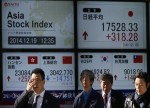
- All Instrument Types
- Indices
- Equities
- ETFs
- Funds
- Commodities
- Currencies
- Crypto
- Bonds
- Certificates
Please try another search

Time To Bet On Mid Cap ETFs?

Given the improving trend in the U.S. market and the assuring data out of Europe, equities could be set to rise higher in the days ahead. While there are some bumps in the road ahead like the possible early tapering of Fed’s bond buying program, longer-term bullish sentiment for stocks seems to remain unruffled. This is especially true for mid and small cap stocks which have played a vital role in carrying the bullish momentum forward.
History has shown that smaller companies generally bounce back in a reviving economy faster than the larger ones. Hence, we might see an upturn in mid-and-small companies in the improving market.
In the spectrum of small-mid-large caps, mid cap ETFs are often ignored compared to their small or large cap counterparts both of which have managed to establish a stronger asset base.
While large companies are normally known for stability and smaller ones for growth, mid caps are arguably safer options than their small cap counterparts, while still offering solid growth prospects when compared to large cap stocks.
Of late, this striking feature about mid-caps has caught the attention of investors as well. Mid cap ETFs have picked up momentum of late, powered by the bullish market sentiment.
In fact, both ProShares Ultra MidCap 400 ETF (MVV) and iShares Core S&P Mid-Cap ETF (IJH) have seen big inflows of about $1.6 billion and $143 million in early August and took their place among the list of top 10 asset creators. Over the last one-year period, the return from SPDR S&P 400 ETF or MDY (24.6%) outperformed the S&P 500 ETF or SPY (17.7%).

Given these performance figures, it is pretty clear that MVV has been delivering stellar performance in the space. So if investors are thinking about making a play on the mid cap market, this leveraged fund could be an enticing option. For investors seeking to learn more about MVV, we have detailed what is behind the outperformance of this fund:
MVV in Focus
Launched in June of 2006, ProShares Ultra MidCap 400 fund (MVV) seeks to provide two times leveraged exposure to the performance of S&P MidCap 400 Index on a daily basis. The ProShares Ultra MidCap 400 ETF typically enters into swap agreements with various financial institutions and futures contracts in order to gain leveraged long exposure in the mid cap U.S. equity space.
The fund is by far one of the most popular leveraged ETFs with more than $1.3 billion in assets. The fund trades in volumes of about 250,000 a day and charges 95 basis points in fees in a year.
Style-wise also, the fund structure is a nice mix of value and growth securities. The fund is also widely spread out among individual stocks thus company-specific risks aren’t a problem.
Since third-quarter 2012, investors’ appetite returned to the riskier assets which led to a dream run for mid- and small -caps funds. Among them, MVV’s performance deserves a special mention owing to its leveraged nature.
MVV has returned around a handsome amount of 57.7% in the last one year ended August 15, 2013. However, it is only appropriate for active investors who can manage their portfolio on a daily basis.
The product also pays an annual dividend yield of 0.04%. MVV hit a low of $62.93 and a high of $112.40 in the last one year. The fund is currently hovering above the $100-mark but still remained behind its 52-week highest price thus offering further room for upside.
Bottom Line
According to us, Mid-cap ETFs need a closer look now. As far as MVV is concerned, the fund is expensive given its mid-cap and leveraged nature. Dividends are also not great, and particularly so in view of higher focus on value stocks.
Still, the fund has shown a strong resilience and is expected to climb ahead in the present economic condition. The index MVV tracks – S&P Mid-Cap 400 Index – is inclined to financial companies and industrials, most of which came up with strong corporate earnings and upbeat outlook which should send this category into another round of rallying.
Just one word of caution is that things will turn opposite for mid-caps, and quite abruptly, if market dynamics changes for some unforeseen reasons.
For more risk adverse investors, a look to unleveraged ETFs in the mid cap space might also be a solid option. These products, like IJH or MDY, have seen solid performances and may be better long-term picks for those seeking to invest in the intriguing mid cap market at this time.
Original post
Related Articles

The major market indexes have struggled this year to produce returns. Many actively managed ETFs have fared better than their index counterparts. Here are 3 top actively managed...

One of the easiest risks to minimize in investing is excessive fund fees. That’s why, when looking for ETFs, you should always try to minimize the management fee, which is the...

Leveraged exchange-traded funds (ETFs) substantially increase the potential reward of an investment by affording investors the chance to generate double or triple the returns of...
Are you sure you want to block %USER_NAME%?
By doing so, you and %USER_NAME% will not be able to see any of each other's Investing.com's posts.
%USER_NAME% was successfully added to your Block List
Since you’ve just unblocked this person, you must wait 48 hours before renewing the block.
I feel that this comment is:
Thank You!
Your report has been sent to our moderators for review





Add a Comment
We encourage you to use comments to engage with other users, share your perspective and ask questions of authors and each other. However, in order to maintain the high level of discourse we’ve all come to value and expect, please keep the following criteria in mind:
Enrich the conversation, don’t trash it.
Stay focused and on track. Only post material that’s relevant to the topic being discussed.
Be respectful. Even negative opinions can be framed positively and diplomatically. Avoid profanity, slander or personal attacks directed at an author or another user. Racism, sexism and other forms of discrimination will not be tolerated.
Perpetrators of spam or abuse will be deleted from the site and prohibited from future registration at Investing.com’s discretion.